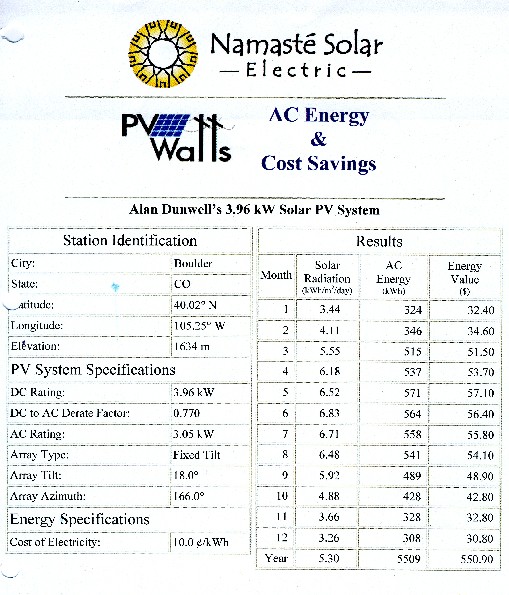Planning
Once I had determined that I needed to just cover my electrical
needs, not try to use the PV for heating as well, it was then time to determine
what size system I needed. Initially I just went over my public service bills
since we built the house to determine what was the overall yearly average
of kilowatt hours (kWh) used. This came out to the number around 425 kWh/month
or 5,110/year. This gave me a ball park bottom limit number to work with.
The other constraint that I imposed was that I didn't want to spend more than a maximum of $20,000, since I wanted to amortize it before I might die. This dollar value was the amount that I would spend, not necessarily the total dollar cost of the project.
There are two moderating items to the project cost, a $2,000 max Federal tax deduction and a Net Metering plan from our Public Service (Xcel Energy). The second is a plan wherein I agree to keep a less-than 10 kW Net-Meter system up and running for twenty years and Xcel agrees to pay about 53% [actually $4.50/watt DC] of the installation costs up front. This plan made the whole project feasible, otherwise I would not have even tried it because of cost. See more details on Net-Metering considerations further down.
At this point I requested bids from five companies, three of which responded and subsequently submitted bid estimates. While cost was an important factor the company history and the materials and plans they submitted were paramount. I finally selected to use Namaste Solar Electric in Boulder Colorado although Simple Solar was a very close runner up.
Working with the Namaste folks we decided to keep all the panels on the roof of the house and further to go with a single inverter which put us up around 4 kW. The final plan was to include 18 120 Watt Sunpower panels, 15 on the upper roof and three on the lower, running to a single Sunpower (made by Xantrex Technologies for Sunpower) inverter. This gave a total system of 3.96kW. Their estimated costing came in with around $13K to me so this was reasonable. They also provided a Solar Radiation Data sheet, and a copy of their estimated amortization schedule, click on the image for more detail.
The solar radiation sheet is actually a reprint from the NREL site and their PV-Watt Version-1 program. The version-1 allows you to select various representative cities, the version-2 allows you to specify by coordinates. This sheet that don't quite match up with my specific site since it is generated by the version-1 using Boulder, Colorado as the location. Most of the specs are very close, but my elevation is actually 8200 feet (~2500 Meters), so the amount of solar radiation is more since there is less atmosphere. The amortization info was also is not quite right for my initial state, and says I will be paid off in about 14 years. It assumes however that I will be using up the full amount of the generated kWh every year and that is not going to be the case since we are over sizing the system. Still it shows that it isn't going to be 25 or 30 years to payoff.
This 3.96kW system is well over what we need for our current electrical needs. Note that there is a difference between kilowatts (kW) and kilowatt hours (kWh) which isn't really a power measurement but a power-over-time measurement See THIS for an explanation.
My rough calculations, using my count of 5110 kWh/year or around 425 kWh/mo current usage, and the 8 average daylight hours available for generation, go like this:
425 kWh/mo divided by 240 hrs/mo = 1.77 KW system
The idea is to run it for a year and log the data from the inverter to see just how much actual extra power is generated. Ideally with a Net-Meter system, you would like to have a zero value at year end. Excess power goes in the meter and winds it backwards, evenings or cloudy days you draw from the grid and run the meter forward, there are no batteries in a Net-Meter system. At the end of the year any excess you have fed into the grid is toted up and you receive a check from Xcel. The catch is that, for current Colorado residential rates, power in/out of the meter is at 10 cents/kWh but you only get 3.414 cents/kWh when they cut the check for any overage. Thus you really want to end up using all the power you generate.
Once we have a feel for the excess we have, then we plan to replace our propane cloths dryer with an electric one. If we still are seeing extra, next will be to install "instant heat" flash boiler hot water heaters in the kitchen and baths and turn down or off the propane hot water heater. We may do this regardless. If we still have excess we'll ponder what to do next, but my estimates seem to indicate we will max out about there. So perhaps in a year or two we will be using the full amount of the power generated and be close to their estimate for amortization.
